

Rebecca Wong - NanoJapan 2015
Grinnell College
Major: Physics, minor in Environmental Studies and East Asian Studies
Class Standing: Sophomore
Anticipated Graduation: May 2018
NanoJapan Research Lab: Prof. Masayoshi Tonouchi, Osaka University
NanoJapan Research Project:Characterizing MoS2-Si p-n Heterojunction Using Laser Terahertz Emission Spectroscopy ![]()
1st Annual SCI Summer Research Colloquium Undergraduate Poster Prize - Honorable Mention
Why Did I Apply to NanoJapan?
Our world is very interconnected and requires global cooperation to tackle the challenges of the 21st century. To create global interconnectivity, we must first establish strong and beneficial connections with various countries, which will require further understanding and respect of different perspectives and cultures that is best obtained by being immersed in other societies. By working together, we can combine brainpower to better address the challenges we face in a renewable energy system. Such is the strength of a program like NanoJapan, which was the perfect opportunity to combine both my interests in East Asian culture with my desire to improve nanotechnology through terahertz spectroscopy. Through NanoJapan, I hope to solidify my educational interests and goals and experience experimental research in photovoltaic nanotechnology.
Japan is not only the world’s third largest producer of photovoltaic energy but is also dedicated to an economy focused on renewable energy generation, storage, and distribution. Japan’s commitment to generate 25% to 35% of its power from renewables and invest billions in improving and releasing renewable technologies makes it my top choice for graduate studies and work in the future, which is why I am learning Japanese and concentrating in East Asian Studies. Nonetheless, eventually working and living in Japan will require more than just studies, and participating in festivals and experiences like the Bon-Odori Festival and tea ceremonies, as well as visiting and participating in Shinto and Buddhist traditions, will allow me to better understand Japanese culture and the forces that have shaped Japan, making me a more understanding and knowledgeable global citizen. Coming from a small, liberal arts college, I am excited to work with talented undergraduates from all across the country as well as experience research at top Japanese universities. I hope to further myself not only in my research skills but also develop new connections and lifelong memories both in the lab and outside of it. I look forward to absorbing all the knowledge I am sure to learn about terahertz technology, renewable energy, and Japanese culture and sacred space.
My goals for this summer are to:
To gain experience and familiarity in experimental engineering working with equipment to fabricate terahertz devices (preferably photovoltaic, but does not have to be)
To have basic Japanese conversations (introductions, hobbies, school) as comfortably and fluently as I do in English
To converse with at least 5 native Japanese people and learn more about Japanese culture and hopefully about Shintoism and tori gates
Impact of NanoJapan
NanoJapan was much more than I could have ever imagined. Through Japan, I learned how to build upon my positive traits in ways different from how I would have in the United States, which allowed me to live life creatively and fully. For example, the United States emphasizes independence in work and highly motivated and driven individuals; this often means working alone on assignments, whether at school or on the job. However, in Japan, I was able to increase my independence not only through my research but also through learning to navigate the public transportation system and travel. Japan showed me that there are non-traditional and not always obvious ways to build upon one’s traits and confidence and that there are always new ways to improve upon one’s self. I know that the lessons I learned in NanoJapan will serve me throughout my career as a renewable energy engineer/researcher and beyond.
My favorite experience in Japan was ... meeting so many incredible people from so many different backgrounds and learning about their experiences.
Before I left for Japan I wish I had brought more unique gifts from the United States. There were so many people to thank, and I definitely was not prepared for that!
While I was in Japan I wish I had... been able to go to Koya-san and stay at a Buddhist temple for the night. On the bright side, it means that I will need to return again someday.
Research Project Overview - Characterizing MoS2-Si p-n Heterojunction Using Laser Terahertz Emission Spectroscopy ![]()
Atomically thin two-dimensional (2D) materials demonstrate markedly different properties from their bulk (3D) counterparts, which could lead to interesting applications for optoelectronic and electronic devices. Advancements in the creation of these 2D semiconductor materials have expedited the fabrication of a variety of 2D-2D and 2D-3D van der Waals heterojunctions with novel properties compared to those of typical covalently bonded semiconductor junctions. However, the characteristics of 2D-3D semiconductor junctions have not yet been extensively studied and are therefore not well understood. The results of this study will provide new insight into the nature of the MoS2-Si p-n junction energy states (e.g., band alignment and bending) as well as allow us to better understand how the properties of 2D-3D junctions differ from those of conventional 3D-3D junctions.
In this study, we examined the emission of terahertz radiation from a heterojunction created with n-type monolayer MoS2 and p-type bulk Si using laser terahertz emission spectroscopy. Using a unique vertical lenses system with optical and terahertz imaging capabilities up to 1 µm, we performed optical and terahertz imaging first of the PCA for alignment purposes and then of the MoS2-Si heterojunction. Though the shape of the photoconductive antenna was able to be resolved as well as the outlines of the numbers and trenches on the MoS2-Si heterojunction, finer tuning will be required to achieve higher quality optical images and eventually terahertz images.
This project relates to my current interests of renewable energy since MoS2 has applications for triple junction solar cells. However, in order to use MoS2 for effective solar cells, better understanding of MoS2’s band gap alignment and bending is required.
Our world is very interconnected and requires global cooperation to tackle the challenges of the 21st century. To facilitate global interconnectivity, we must first establish strong and beneficial connections with various countries, which will require further understanding and respect of different perspectives and cultures that is best obtained by being immersed in other societies. NanoJapan provided the perfect opportunity to strengthen my understanding of global relations through improving my knowledge of Japanese culture, religion, and attitude. Working with researchers of all different background in a Japanese setting allowed me to better appreciate the differences between research in the United States and Japan and the different techniques and requirements for research, even if the end goal is the same.
I am certain I would like to continue to do research in the future and pursue a Ph.D. in mechanical or electrical engineering. NanoJapan proved to me that regardless of the difficulties of research, it is the right path for me.
General Overview of Lab Environment
Tonouchi laboratory was incredible. Everyone is happy to meet you and very kind, though maybe a bit shy at first. I was really thankful for all the wonderful preparations that Iwami-san (the secretary) and other researchers made, including day trip outings and picnics, to make me feel welcome. In my previous research experience, it was rare that I ever saw the professor as he had an office outside of the lab and was very busy singlehandedly managing over 30 graduate students. Tonouchi laboratory has one sensei that is always in the office, which I personally like because it creates an accessible atmosphere where students can ask questions anytime. I also like how there is a lot of inter-collaboration between different lab members on a single project and the open communication within the lab since everyone is in the same room. Though everyone is always busy, the environment is not stressful. It is really a great place to research.
TJ was an awesome mentor. It helped a lot that he started me off with an automated terahertz spectroscopy machine before having me work with the much more complicated home-made terahertz system. I also enjoyed learning more about the Raman spectroscopy using the Horiba XploRA ONE. He made sure to explain how things worked and what was going on with the system. Though I still only understand a bit of terahertz spectroscopy, I truly have learned a lot this summer.
Outside Activities
My laboratory organized a daytrip to Osaka-Kizu Wholesale Market, Yashui Shrine, and Tennouji Zoo as well as a picnic at Expo '70 Commemorative Park. We also sometimes shared lunches at the cafeteria, especially when I just joined the lab and when Cody arrived in Japan. Finally, there are the wonderful parties thrown whenever new members come and old members leave. Japanese labs really have a festive spirit.
Daily Life in Japan
Life was very regular. I would research for five days a week, Monday through Friday (though research itself was not in the least regular). On some days, there would be so many tests to run or data to analyze that I would need to run to catch the last bus or sleep in lab. On other days, there was nothing I could do as the system needed to be completely realigned, and I spent the day reading more articles. Research is just that way though. On the weekends, I took numerous trips, sometimes with lab mates, other NanoJapan students, and even strangers. Other times, such as long, unplanned hikes, I went alone (make sure you can read some Kanji or plan your route well if you do this). Many of the excursions either involved my personal interest in religious shrines and sacred spaces or the outdoors.
When I first arrived in Japan, I felt very much out of place, and the trivial differences, from small, squatting toilets to the very enormity of Tokyo, made me feel even more isolated and alone than ever before. However, the Japanese people who have come to support us and help us throughout our journey in Japan have both greatly aided in this transition and have changed my outlook. The very first of these people was Packard-sensei. Despite my never-ending ignorance and multiple cultural faux-paus, she has been there to guide me towards becoming a more polite and culturally sensitive global citizen. For example, within one of the Buddhist temples, I committed the classic tourist sin: photo-taking. Though photos in and of themselves are harmless objects, Packard- sensei explained that the action of taking a photo is akin to taking the life and soul out of the temple and sacred objects within. Therefore, doing such was not appropriate. Perhaps such a minor matter was not so important; after all, the monk in charge of the temple did not reprimand me, and I had only been here for a week, so ignorance was expected. Nonetheless, we had learned prior that Japanese people are not as confrontational and direct as Americans tend to be and do not always expressively show their disapproval. Even more importantly, I want to move away from being a stereotypical “ignorant and culturally insensitive” American and better appreciate the culture, traditions, and beauty that surround me.
Meeting and befriending so many new people, including the KIP students and lab members of Maruyama lab has been wonderful, and despite my constant failed attempts to use Japanese, everyone has been extraordinary patient and encouraging. I am especially appreciative that despite my shortcomings in Japanese, the KIP students and lab members do not encourage me to revert back to using English to communicate, something I expected since they speak English very well. I also distinctly remember the first moment I was exceptionally touched by the patience of a Japanese person, someone we had worked with in the rice paddy. He patiently taught me new words and helped me as I stuttered and flailed to have a simple conversation. Though simple, these actions touched me immensely, and I left the rice fields feeling a great happiness and sadness at having made so many new friends that I must constantly leave behind.
My experience with intermediate Japanese language classes here has been one of great struggle. Coming from a background where grammar structures and vocabulary are emphasized over kanji, the first class came as a complete surprise. I found that I could read and understand almost nothing, and it was a horrifying experience. Nonetheless, I am thankful for the push from Shimojo-sensei and the continuous faith and help provided as I struggled to comprehend even basic technical Japanese. So far, I have been writing large lists of kanji and vocabulary to take with me wherever I go, so that whenever I find a free moment, I can practice and memorize. Already, I can tell I’ve learned a lot, but nonetheless, it has been very difficult getting the words to stick as well as those that I learned back from my Japanese classes at Grinnell College, where lessons were much slower. My classes at Grinnell were also easier as they were focused on conversational rather than technical Japanese, which is very difficult to practice outside of the classroom. Another challenge has been the limited time. With constant classes, lectures, and cultural outings, what little free time we have is often spent sleeping or experiencing new sights and cultural aspects of Japan. Balance clearly is the key to life, and it is something I will just need to improve upon.
Question of the Week
Why are there such strict divisions between each part of Japanese life (changing of shoes from the outside to inside of the house as well as for the bathroom)? Does it have to do strictly with cleanliness, or is it also symbolic?
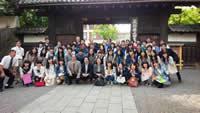
Taking Ueda by Storm: We are standing in front of Ueda High School’s front gate with several KIP students and Ueda High School students, ready to explore the amazing wonders of Ueda City, including the very famous Ueda Castle.
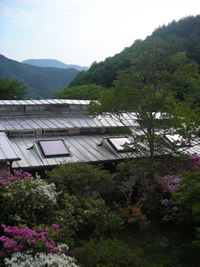
The View From My Backyard: This is the view from the ryokan we stayed at in Nagano. Already, in late May, there are a variety of wildflowers blooming in the gardens.
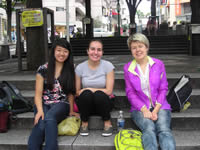
On the Steps of Happiness: Alena, Julia, and I are sitting on the stairs of a little park in downtown Azabu-juban enjoying lunch and baked goods from Mont Thabor Bakery.
Intro to Nanoscience Seminar
The NanoScience lectures have reinforced much that I have learned this past school year, and it is exciting seeing how all the various aspects I learned in physics class are integrated and connected with one another. Seeing material that I had previous learned in Modern Physics and Mechanics, such as the Hamiltonian and energy-momentum diagrams as well as quantum tunneling and classically allowed regions, has been really beneficial, especially since introductory physics classes gave me little foundation for my research last year. In particular, I have found energy-momentum diagrams useful for understanding intraband and interband dynamics and comprehending how different materials, such as various semiconductors and graphene, differ in their properties based on band gap. I also appreciated the general introduction into THz technologies as well as their useful applications as I was largely unfamiliar with such technologies until the program itself began. During the NanoScience lectures, we have focused extensively on classical mechanics vs. quantum mechanics as well as differences between insulators, metals, and semi-conductors in terms of band gap and other properties. We have also investigated the distinction between 0D, 1D, 2D, and 3D systems, which correlates with the degrees of freedom of a system. For my research, it will be important to better understand the two types of lasers: continuous wave, which has a single frequency and coherent pulse over a long period of time, and pulsed, where lasing acts only for a short period of time, meaning that there are several different beam frequencies. I hope to gain a better understanding of optics and learn how to interpret band gap diagrams to identify the properties of different materials. Since I have had little exposure to optics, I look forward to learning more about various optical properties and how to use them to characterize different thick and thin films.
Initial Research Project Overview
I will be further researching a simplified version of a heterojunction formed between n-type monolayer MoS2 and p-type Si, which is a 2D-3D system. MoS2 is the most common transition metal dichalcogenide (TMD) material being studied, and Si is similarly the world’s most common semiconductor being studied. Because both materials are already being researched extensively, and Si is used in a wide variety of applications, these materials are excellent for testing our understanding of a bulk-2D interface. For example, Si is already widely used in integrated circuits as well as in high-efficiency photovoltaics, and MoS2 can be used for photoelectrical-chemical and microelectronics applications and can possibly serve as a photodetector. I will observe the characteristics of this heterojunction, including photocurrent, charge generation, separation, and flow dynamics. Similar to past experiments on a more complicated version of this heterojunction, I will probably be using lasers of various wavelengths to explore these properties. By using lasers of varying wavelengths, including a laser that is larger than the MoS2 quasi-particle band gap, another that is larger than the MoS2 optical band gap but smaller than the quasi-energy band gap, and one that is smaller than the MoS2 optical band gap but larger than the Si band gap, we are able to observe the various properties that occur at different pumping wavelengths. We can then see the efficiency of the THz emission compared to the pumping energy and the spectral shape of the THz emission of the sample and use band diagrams to better understand our findings.
Being in Nagano was a true blessing in helping me remember myself and find my roots. The land, with its beautiful rolling green hills and lush forests, reminded me so much of my Colorado home. Nagano was the first time in a long time that I felt a deep connection with the land. Despite being there for only three days, I felt at home in Nagano, which is rare for a person like me who attaches little significance to place. One of the first things I noticed about Nagano that made me fall in love with the place and the people was the way that people connect with the land and thus incorporate it into their very way of life, something I very rarely see in America. I saw how the land was the source of not only rice and buckwheat but also the grounds for praying, eating, and music, the heartbeat of the land itself.
In Nagano, one of my favorite experiences was connecting with the food I was eating. Living in America, there are few chances to really understand your food and go through the process of growing it and making it yourself. In our world of quick fast food conveniences and pre-packaged goods, it is rare indeed to understand where your food comes from. I’ve eaten rice every day for almost all of my life, but I had never seen a rice plant before, let alone helped nurture one. Planting rice allowed me to connect back to my simpler roots and see how these small, feeble rice shoots grew from the muddy fields, nurtured by the humans who planted them carefully finger deep and a palm’s width apart. As I planted the rice and helped it to grow, I remembered how life is a continuous circle where the people tend the rice and the rice nurtures the people with nutrients and energy. I also had the good fortune to make my own soba noodles from scratch. Though the noodles were by no means perfect, knowing that they were my own and created from good ingredients was very reassuring. Rediscovering the basics of life in a society that has become so busy, complex, and mechanized has been insightful and uplifting for me. It reminds me of a talk I had with one of the farmers, who spoke of how the land and humans are interconnected, something I feel is well expressed by調和, the harmony between nature and humans. It is wonderful to reconnect with the land through something as beautiful and simple as food.
My second insight occurred during a short hike to a tiny, unnamed shrine. Like many of the shrines around Japan, it appeared out of nowhere. I love how one can be in the heart of a large city or far in the mountains and, in any case, find a shrine or temple that is so beautifully incorporated into the land that it is almost impossible to tell it apart from the land itself. This shrine was particularly unique because of all the small statues that lined the hills, calling to the memories of loved ones and prayers and wishes waiting to be realized. Like a scene straight out of a Miyazaki film, the statues lined the hills, scattered among the tangled roots of the old pines. Because the statues were each made by different individuals, they each had a different style and paid tribute to a different animal or person. Each one had its own story to tell, and I thought that was beautiful. To see that deep-rooted connection between humans, nature, and spirituality made me realize that helping reconnect humanity with nature was not an impossible dream. It was the inspiration I needed to continue to strive to create a world where humans and nature live together in harmony.
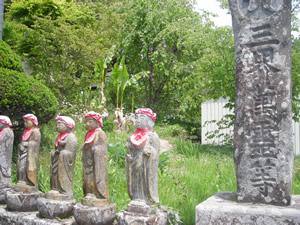
At Peace With the World: At an unnamed temple, we saw a variety of statues, each dedicated to a different person or creature.
The final small awakening occurred while Taiko drumming. The master spoke of how the Taiko drum symbolized the very sound of the human heartbeat, a sound that relates us all to one another and that no person can hate. Watching the children perform, in sync with each other and their heartbeats reminded me again of the harmony felt between people, culture, and the land. Performing myself only further solidified this feeling. Japan is truly a land of harmony, and through my experiences in Japan, I know I will find the balance and harmony for myself that make this land so remarkable.
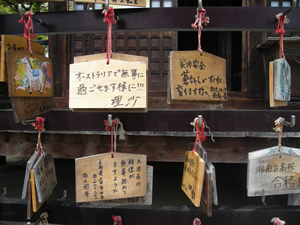
Wishes On Wood: Prayers and wishes written on wood, ready to be realized.
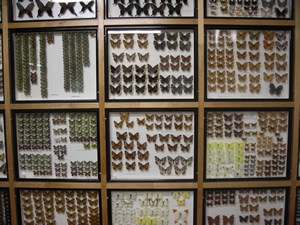
A Wall of Wings: On a visit to the Insect Museum of Shinsyu, we saw a variety of butterflies and insects from all over the world.
Question of the Week
There are so many areas in Japan that have shrines and temples. Are they all considered equally important? If not, which area in Japan is considered the most sacred?
>> NanoJapan Tip: Koya-san is considered to one of the most sacred spots in Japan and 2015 marks its 1,200 anniversary. It would be an easy weekend trip from Osaka this summer.
Intro to Nanoscience Seminar
Our NanoScience lectures this week were a continuation of last week’s lectures. For these lectures, there was particular emphasis on differentiating between insulators and metals, which can be effectively done with resistance vs. temperature graphs. We then did further research into graphene and carbon nanotubes (which can simply be considered as a rolled up sheet of graphene) and their specific characteristics including their unique band structure, strong coulomb interactions, and ultra-high carrier mobilities. Graphene is an incredibly remarkable material as it is super thin, 300 times stronger than steel, and a thousand times more conductive than silicon. These properties can then also be somewhat changed depending on how graphene is rolled and shaped. Additionally, graphene is a noteworthy material as it has no band gap, which means that it has no gap in energy between the electron-filled valence band and the unoccupied conduction band. This trait means that graphene is not a semiconductor, metal, or insulator. Because of graphene’s special properties, electrons in graphene move ultrafast and basically act as if they are massless, and carbon nanotubes can absorb the whole spectrum of light, which can be useful for solar cells. Further lectures and explanation on band gap and how it relates to energy and momentum would be especially useful. I would also appreciate more information on how to characterize the materials we will be working with and understand their various unique properties.
Preparation for Research Internship - Article Review
As part of my research this week, I was asked to read the following publication by Masato Suzuki, Masayoshi Tonouchi, Ken-ichi Fujii, Hideyuki Ohtake, and Tomoya Hirosumi entitled “Excitation wavelength dependence of terahertz emission from semiconductor surface.”
M. Suzuki, M. Tonouchi, K. Fujii, H. Ohtake and T. Hirosumi. "Excitation wavelength dependence of terahertz emission from semiconductor surface," Appl. Phys. Lett. 89, 091111 (2006). http://dx.doi.org/10.1063/1.2338430
The purpose of the research was to measure terahertz radiation emitted when InSb, InAs, and InGaAs were excited by femtosecond optical pulses at various wavelengths (1560, 1050, and 780 nm) and to analyze wide band gap semiconductors and characterize their properties.
Usually, large amounts of terahertz radiation require high power femtosecond Ti:sapphire lasers with wavelengths of around 800 nm. Using second harmonic pulses generated by fiber lasers offers a new way to generate terahertz radiation in a stable and portable way. However, fiber lasers have one-fourth of the power of traditional Ti:sapphire lasers; in order to make more efficient fiber lasers, more efficient terahertz devices for infrared beam need to be fabricated, which is the purpose of this research.
InSb and n- and p-type InAs were chosen as test materials because these semiconductors had been previously extensively studied, and it was determined that the terahertz radiation emitted from these semiconductor surfaces is related directly to the energy of the pump pulses and the band gaps. However, these studies did not thoroughly investigate a variety of semiconductors and exclusively looked at semiconductors with narrow band gaps much smaller than the energy of the 1560 nm optical pulses. Therefore, the authors investigated the above two semiconductors along with lattice-mismatched In0.60Ga0.40As and lattice-matched In0.53Ga0.47As, which were grown on semi-insulating InP substrates by metal organic chemical vapor deposition. In0.53Ga0.47As has a particularly large band gap (0.73 eV), which is just slightly less than the energy of the 1560 nm light. The lasers were aimed at an incidence angle of 45° and focused on the surface of the semiconductor by a lens. They found that the terahertz pulses from InSb excited by the 1560 nm pulses were higher efficiency than other wavelengths, especially 780 nm, which was the weakest. Since terahertz field strength is related to the time derivative of surface photocurrent induced by femtosecond excitation, it is important to measure peak current, which can be determined by the electron temperature. The electron temperature dependencies can be explained by intervalley scatterings, effective mass, and absorption coefficient. For the 1560 nm light, electron temperature was dominated by surge currents of carriers in Γ valleys. It was found that the surge currents of narrow gap semiconductors is greater than that of large gap semiconductors due to small effective masses and large absorption coefficients, which supports the theory that band gap depends on surge currents. Carriers in L or X valleys are the main contributors to peak current of 1050 nm and 780 nm excited InSb due to intervalley scatterings, which reduce peak current since they have greater effective mass than Γ valleys.
This work re-verified that the amplitudes of terahertz waves are strongly dependent upon pump wavelength. They found that InSb had the highest terahertz emission of the semiconductors tested (when excited by the 1560 nm), and that L and X valley carriers have lower mobilities than Γ valleys, which results in reduced terahertz emission. Therefore, it was found that semiconductors with small direct band gaps and large indirect band gaps offer high terahertz emission efficiencies, making it possible to build a compact terahertz system utilizing fiber lasers.
One of the most wonderful things about Japan is its organized, timely public transportation system. Unlike the United States, Japan has well thought-out train and subway lines that maximize efficiency, including usage of multiple waiting lines and designated areas on escalators where people stand and walk. In a country as squeezed for space as Japan is, it is no surprise that strong public transportation systems are required in order to improve quality of life both in reducing traffic as well as pollution. In contrast, America is an enormous country with a much lower population density and, as such, it is possible for this land to be dominated by automobiles, which require large amounts of space for parking garages and gas stations. Because of the popularity of every individual owning his or her own car, highways and roads sprawl all over the country, with cities and suburbs often fairly far from one another. For this reason, establishing a public transportation system on the scale of Japan’s in America is almost impossible. The American public transportation system is therefore much less convenient than in Japan. Whereas in Japan, missing your subway or train means a matter of minutes until the next, doing the same in America often means waiting another 30 minutes to an hour. Additionally, the public transportation systems in America are much more difficult to use as there are few maps and signs to guide travelers. Having never taken a subway in my life prior to being in Tokyo, I was able to do a trip alone my second time and figure out the system myself, something that would have been nearly impossible in America.
On the trains and subways of Tokyo, people tend to stay quiet. Usually, people stick to themselves and use their mobile devices or read a book. Though I do appreciate the quietness, it is rare that I even see friends talking to one another, opting instead to be on their mobile devices. On the few occasions that people are conversing, they keep it to a low volume, or, if on a phone, they apologize to their friend, stating they must be quiet since they are on a bus. This discrepancy between Japan and America made it very easy to distinguish our group as one of foreigners. Not only are we different in appearance, but our mannerisms are very much the opposite of the native Japanese on the bus: rambunctious and noisy. As a group, we often get excited about a great many things, and everyone is always loudly talking or playing games. Though I appreciate the rowdy, cheerful ramblings of our group, it is probably not appreciated by our counterparts on the train who are attempting to read or just sleep after a tiring day at work.
Since few people own cars in Japan, the subway and train systems are always fairly full, especially during rush hour. In a survey of Japanese people conducted to determine what would be considered the single, worst thing one could do on a train or subway, the overwhelming majority of people agreed that improper sitting was the worst possible behavior on a train. At first, I wasn’t sure how this issue could be so bad. After all, in America, there is often extra space, and personal space is a nice luxury whenever possible. However, the first time I rode the subway in Tokyo, I immediately understood. Taking up an extra seat is rude, especially since it deprives people exhausted from work of a chance to relax and wind down. Even worse is taking up extra seats in the priority area, designated especially for the elderly, disabled, and pregnant. During our field trip to the Edo-Tokyo Museum, I was told by one of my senseis that it would be best not to sit in the priority areas and to avoid it whenever possible, even when there are no elderly, disabled, or pregnant individuals waiting for those seats.
Packard-sensei also explained to us that a more recent phenomenon has been the movement of the personal life into public life. In America, it is not necessarily rare to find someone putting on makeup and driving. However, in Japan, the separation between private life and public life is well-defined, and thus, putting on makeup in a train is a very strange phenomenon indeed. Packard-sensei described the way in which the woman flawlessly put on her makeup, even with the bumps and tumbles of the train, meaning that this procedure was somewhat of a habit for her. Perhaps it indicates a small shift towards Western attitudes, but it is hard to be sure.
Question of the Week
This leads to my question of the week: In recent years, have Western attitudes been more successful in being adopted by Japanese society?
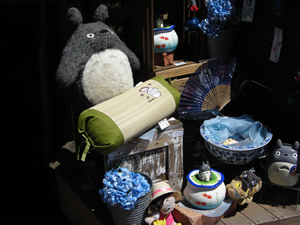
My Neighbor Totoro: Surprisingly located in the middle of Kamakura, I was immediately drawn to this store. Miyazaki’s creations, including Totoro, represent both my first interest in Japan as well as the beginning of my love for nature.
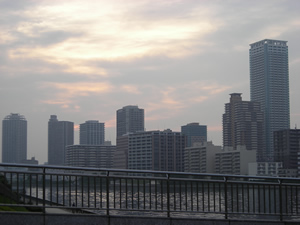
A Streak Of Light: 5:00am Sunday morning at Tsukiji. Though the tuna auction and market unfortunately do not occur on the weekend much to my dismay, I did see a beautiful sunrise over the harbor and enjoyed some good sushi.
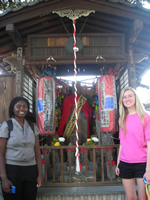
Shrines Galore: Right next to Sanuki Club Hotel is this beautiful shrine. Small shrines such as these are located everywhere throughout Tokyo. Models include Jacqueline and Katherine.
Introduction to Nanoscience Lectures
The NanoScience lectures this week focused on a wide variety of topics, but the one of the most interest to me was the different kinds of tunneling phenomenon that occur due to graphene’s unique band gap properties. For example, graphene undergoes Klein (Chiral) tunneling. Unlike quantum tunneling, the tunneling behavior is increased as the barriers increase. Therefore, in more classically forbidden regions, the particle is more likely to be located in those regions. Even though the barrier may be very high, the particle, which is moving at a speed near light, treats the barrier as if it is transparent. It protects high charge carrier mobility, which is why graphene is so conductive and impossible to “turn off.” Another topic of interest to me was lattice matched vs. lattice mismatched. Lattice mismatched allows certain kinds of materials to bead up on its surface, almost like oil and water. It can therefore be used to create quantum dots.
Even as the NanoScience lectures come to completion, I wish there was more time to learn more. In particular, I would like to understand more about semiconductors. Graphene is incredibly interesting, but I feel I do not have a good grasp on other materials and their special properties. In particular, is there a certain metal, insulator, and/or semiconductor whose properties it would be important to know?
As move into my research host lab next week, I would like to have a better understanding of MoS2, the material I will be analyzing, as well as the procedure required to align the lenses to observe terahertz emission and other properties.
Before I started my first research experience, I was under the ridiculous impression that research would be simple; I would tinker with a couple different experimental set-ups and magically produce ground-breaking results. I found out the first day of my research last summer that this view is far too idealistic. As this experience marks my second time researching, I was not caught by surprise when I spent most of the days this week reading about terahertz spectroscopy and semiconductors in anticipation of the work I would do. The readings I have done have been important for improving my understanding of semiconductor properties as well as principles of terahertz science and technology. I also got to see the systems I would be working with in a building aptly named Twenty First Century, and TJ, my mentor, demonstrated imaging a chip for alignment purposes using an infrared camera. The careful alignment of the parabolic mirrors and lenses is absolutely remarkable, and I greatly admire the many people who have devoted countless hours to creating these homemade systems. Though I have not started my actual research on the MoS2-Si heterojunction (it is expected to arrive within a few weeks), I have been gaining a better understanding of terahertz spectroscopy through the use of an automatic terahertz spectroscopy machine. I am currently analyzing two silicon chips to see if I can accurately determine their pre-measured resistance values using the data I acquired from the spectroscopy machine. I think this activity will be very useful for gaining a better understanding and appreciation of the research I will be doing. A solid foundation is the most important element in early research, so I am happy that I am building a strong one, but I am slightly worried about having data to analyze for the MoS2-Si system before the end of the two months.
Everyone in the lab is incredibly friendly and welcoming, and Tonouchi-sensei graciously treated us all to a wonderful welcome lunch at Mineruba. I had the “Royal Lunch,” which included tasty beef with bacon on top; Tonouchi-sensei recommended that I try Kobe beef, which I will be sure to do. Otherwise, the day proceeded as normal, and I appreciated that. The lab itself is international, so English is the working language. However, English/Japanese fluency varies immensely, and there seems to be a pretty sharp divide between English speakers and (primarily) Japanese speakers. For example, TJ and Manja only speak English (though both are considering learning Japanese if they stay longer). On the other hand, besides for the senseis and Iwami-san (the secretary), the Japanese lab members generally only speak Japanese, though they can all speak a bit of English when necessary, such as when they talk to TJ. Though my own Japanese language ability has no relevance to my research currently, it has been important for bonding with the Japanese lab members. During a weekend excursion to the Osaka-Kizu Wholesale Market, Yashui Shrine, and Tennouji Zoo (kindly arranged by Iwami-san after hearing about my failed attempt to see the Tsukiji Fish Market), I was able to talk to the Japanese lab members and Iwami-san almost entirely in Japanese, and it definitely improved the dynamic between me and the group. I was happy to practice Japanese and also have them ask me questions in English. I think it was a great language learning experience for all of us, and of course, the trip itself was a blast with lots of wonderful food and friends.
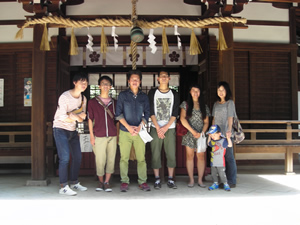
A Warm Welcome: My first field trip with part of the Tonouchi lab; I already feel like a part of the group. This picture was taken at Yashui Shrine.
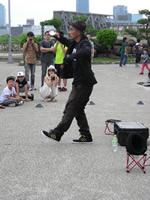
Japanese Talent at its Finest: By chance, I got to see this street performer on my way back from Osaka Castle. He was performing a crystal ball illusion trick in the photo but he also spun hoops and could dance like no other.
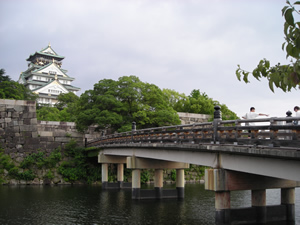
Rising From the Ashes: Osaka Castle in all of its glory. The original castle was completely burned down, so it was completely rebuilt again, which I find inspirational for some reason.
TJ is a great mentor. He explains everything he does, so even though I have no optics background besides my introductory level courses, it has been a bit easier grasping this new material. He is also incredibly laid-back and does not like to show up as early as I do, opting instead to stay late and work significantly past dinner time. It is apparent that everyone is expected to work long hours, regardless of efficiency level. In order to have a good reputation with both lab mates and senseis, one must work just as long as his/her lab mates (senseis generally work even longer); otherwise, one is seen as lazy and uncommitted to the research and team. I have also talked extensively with Manja, a researcher from Madagascar and a good friend of TJ’s. They have both helped me extensively with my understanding of terahertz systems through diagrams and explanations, and I am glad to have them as my mentors.
The dorm situation is amazing. I was actually surprised at how nice it was. It comes with a full kitchen (fridge, sink, and stove) as well as its own bathroom. Though the bathroom is exceedingly small, I can’t complain really since it’s incredibly convenient. The place even has its own washer and a nice little patio in which to hang clothes to dry, which reminds me of my childhood home where I used to line-dry my own clothes. As if it didn’t already have everything, it even has its own wireless modem. It’s been a wonderful set up. The commute is a bit long (30 minutes), but as the bus comes every 20 minutes, it is really not much of a problem, and the commute is worthwhile to have such nice housing. Overall, the living situation has been incredible, and though smaller than my room in the United States, I would say it is better here since there is no need to deal with the messes that constantly occur in communal kitchens and bathrooms. So far, the entire laboratory experience has been amazing in all ways, and I am excited for the coming weeks.
Assessment of Orientation Program and Language Classes
The orientation program’s language classes as well as the cultural and nanoscience lectures have been extraordinarily beneficial. The kanji and technical vocabulary I learned in language class appear surprisingly often, and I recognized some of these new words on my walks around campus. I have also noticed that I pick up new words more quickly than before as I was able to learn and retain a variety of different zoo animal names during our weekend excursion. Though the cultural classes and nanoscience lectures were good for general background, I have not been able to utilize the information I have learned from either of them all that much. Nonetheless, all of these courses were incredibly invaluable, and I know they will strengthen my overall understanding of Japanese culture and physics as I continue my education.
However, in this present moment, I think the most essential experiences were those learned outside of classes, and I would have appreciated a less structured schedule with more time to explore. For one, I learned invaluable skills communicating with shopkeepers and ordering food. Despite all my Japanese language training, I still find ordering food one of the hardest and most challenging language tasks in Japan, and only more practice will help me to recognize the key phrases used and become more fluent. My goal for now is to be able to recognize these key phrases such as how many people are in your party and eat-in versus take out.
The orientation period was also essential for understanding how to navigate the public transportation system on my own. Learning how to do so in Tokyo made it much easier to transition to using Osaka’s subway and train systems, which I find slightly more confusing as they are not as well labeled as Tokyo’s. Navigation has been one of my greatest challenges thus far, and it has been intensified by the fact that few people speak English well, which surprised me since the Japanese students at my school speak English just as well as I do. One of the most difficult situations was when I attempted to find the chemistry department at The University of Tokyo to visit a lab I was interested in working at the following summer. Despite it being a university campus, asking for directions to the East Chemistry Building in Japanese and English was difficult, even though I knew the words for east, chemistry, and building in Japanese (in fairness, perhaps a direct translation made little sense). Though it turned out to be a problem based less on language barrier and more on lack of knowing the different campuses, I am still convinced that such a scenario would have been much easier to handle with Japanese proficiency. Internet access through my mobile phone would have also been incredibly beneficial for both finding the location as well as for translating key words. Though I do not have a smartphone in the United States, I would definitely buy one in Japan.
Question of the Week
Though I have learned much, I am still wondering about a few, trivial things. How do 100 yen shops sell so many nice things that dollar stores in America cannot? Similarly, how are konbini umbrellas so nice and fashionable?
Research Project Update
I will be performing terahertz spectroscopy on a MoS2-Si heterojunction. I am not sure what to expect for my results as I do not believe I will be analyzing the same properties as previously studied. If I am confirming properties, however, I would expect the results found in these previous studies. For example, one study found that MoS2–Si is best modeled with a Type-I band diagram and that photoresponse only occurs at the MoS2-Si heterojunction with a perfect match between the photoresponsive region and the trench region in the optical image. Another study looked at temperature dependence and observed that acoustic phonon scattering is the dominant mobility-limiting mechanism at 200 K in MoS2-Si systems. For my own experiment, I will be using and partly assembling a terahertz spectroscopy system that utilizes a detector, emitter (photoconductive antenna), femtosecond pump laser, beam splitter, parabolic mirrors, lenses, chopper, and time-delay stage. However, prior to beginning this research, I will be performing terahertz spectroscopy on silicon chips as well as extensively researching the properties of MoS2 and giving a formal presentation on it. I will also receive training on how to align a terahertz spectroscopy system. For now, I will likely just continue to practice with the automatic terahertz system while learning more about the equations and theory behind terahertz systems. After the mid-program meeting in Okinawa, I will hopefully have results from performing terahertz spectroscopy on the MoS2-Si sample. I will then begin assembling a new terahertz system for future use while working on a poster and presentation for the RQI Colloquium.
Research Questions: What properties will I be analyzing in the MoS2-Si heterojunction? Besides for practicing taking terahertz spectroscopy measurements and reading more journals to better understand terahertz spectroscopy, what can I do to better prepare myself for analyzing the results I find?
Surprisingly, despite my recklessness, I have not yet endured a serious cultural mishap. The only issues I have encountered thus far are literal misunderstandings of spoken Japanese, and the problem is usually fixed with a few gestures or English phrases (and of course, much embarrassment on my part). If anything, Japan has been a land of tolerance and understanding for the overtly American tourist I have been and seemingly will always be (and there goes my Week 1 goal). Cultural misunderstandings have therefore been quite rare, and I am thankful for the outgoing, forgiving, and respectful nature of the people here. I have received warm welcomes from random strangers, including a tour guide at Himeji Castle who by chance walked up to our group and began to excitedly explain the history and architecture of the castle to us. As a thank you for being such an attentive audience, he gave us each an origami shuriken; the origami gifts seem to be a trend in Japan, and I absolutely love it. I was also given a warm welcome from the Forró (Brazillian dancing) class. I was introduced to the group by Roy, another member of the Tonouchi Lab who occasionally dances with the Forró group. Though I was born with two left feet, I thoroughly enjoyed meeting all the talented and friendly dancers and swinging around the lounge of Toyonaka International House. Even the strangers on the streets have been remarkably kind, and though my carelessness could often lead me astray quickly, Japan has taken care of me. On my way to the subway station in Akihabara, a random stranger came up to me and began to talk to me. As one should be, I was slightly wary at first, and looking back now, I wish I was more careful and diligent about my safety. Nonetheless, the man was really kind and genuinely just wanted company. He treated me to dinner and karaoke, and then I went home. There is a respect for women that I have seen in Japan that I feel would be impossible to find in the United States, and if anything, this tacit respect has saved me from many cultural and social misfortunes. I am just thankful that all has been well thus far.
Question of the Week
All around Osaka University, there are posters regarding sexual harassment. However, I have never felt so safe in my life (not a single inappropriate touch on public transportation or cat-call since I have been here). Does Japan actively address sexual harassment issues in a way that the United States does not and has that thus led to fewer instances of sexual harassment?
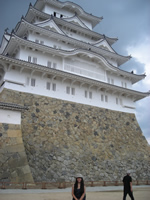
Restoration Complete: I am standing in front of Himeji Castle, where renovations were just completed this past March. Though neat to go inside, I was disappointed by the lack of historical information within.
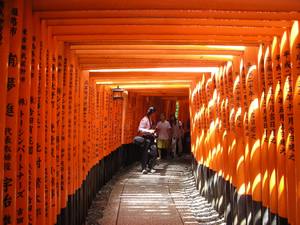
Sunlight Filtering Through the Gate: These are the beautiful torii gates lining the path at Fushimi Inari Shrine. I love the way that the sunlight seeps in, making one feel as if she is walking on a bridge of light.
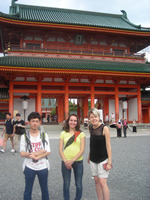
Reunion!: Alena, Julia, Tomoki, and I visited many areas in the Kyoto area. Among them was Heian Shrine, a beautiful, vivid red Shinto shrine. It was a lovely day trip.
NanoJapan Research Project Update
This past week has been focused around improving my understanding of terahertz spectroscopy. I therefore analyzed the results I received from the TR-1000S Automated Terahertz Spectrometer on my silicon chip sample. From the data, I was able construct an excel sheet to calculate each individual frequency data point and create an average value for the two electric permittivity values (I) as well as the two optical conductivity values (II).
TJ still needs to improve the alignment of the homemade system to be able to properly image the terahertz emission from the MoS2 monolayer. In preparation for imaging the MoS2 sample, he has been imaging another sample containing a photoconductive antenna whose terahertz emission is easier to detect. However, since the waveform data looks slightly irregular, there has been a bit of hesitancy in moving forward just yet (he will be consulting a post-doc on the data). However, since the MoS2-Si heterojunction has not yet arrived, our progress has been just fine.
The only issue that has been greater than the language barrier has been the combination of my ignorance and presumptions. The first time this combination led me astray was in trying to find my way home from the subway station. The morning prior to getting lost, I managed to get to Ishibashi Station on my first try using only a map and without previous knowledge of the campus where I am staying. After returning from the day trip with my lab mates, I came back to Ishibashi Station, confident that I could easily find my way home. Though I did not recognize the West Exit side (it turns out I came from the East Exit side), I figured it would be fun to explore the area and that I would still easily be able to get home. I found the main intersection right in front of the station easily enough, but when I attempted to go home, I found myself lost in a neighborhood that looked very unfamiliar. I then decided to travel the opposite direction. After hitting a large road that I knew I had not seen earlier and unable to recognize anything else I saw in that direction, I decided that the first direction was the only possible way I could have come from and backtracked for another 30 minutes. Eventually, I managed to convince myself that I recognized some of the neighborhood streets, but when I came across an intersection of street paths where none of them looked familiar, I knew I was lost. I then had to use the GPS on my phone to find the main highway and then walk around the campus to go home. A trip that should have taken 30 minutes quickly became two and a half hours. Ironically, my initial assumption that the intersection was correct was wrong, so I could not have gotten home from where I was using what I remembered from earlier that day. This story now transitions smoothly into my next crisis: data usage. I have never owned (and therefore never relied upon) a smartphone in my life, and I am actually very proud of that. But my ignorance about smartphones soon came back to haunt me when I received my phone bill for last month. I had played with my Japanese phone on a wifi connection as soon as I got it, logging into Facebook and checking the news. I found it strange that there was a 3G symbol at the top, and after trying to disable it and finding I could not, I figured it was just there to state that the rental phone had that capability. Ever since that day, my Facebook, news, and weather app have auto-updated themselves each night using 3G, leading to quite a terrible surprise the following month. Both of these lessons have been incredibly painful, but I am continuing to learn and stop making assumptions about things I know nothing about.
However, being in Japan has also helped me to see the best in tough situations and to forgive more easily. I have begun to accept my failures and mistakes as new lessons to learn from and have stopped beating myself up over them. I have also been able to better appreciate my small successes, such as being able to maintain a conversation with my lab mates as well as make a reservation in Japanese, navigating the subway and train stations by myself, keeping calm in terrifying situations, and maintaining my patience during experimental difficulties. Sitting outside on the balcony of my dormitory on the sixth floor, I have had a lot of time to reflect on how far I have come both literally and metaphorically. Coming to Japan with a group of strangers was an enormous leap for me; not only had I not been outside of America since going to Hong Kong when I was five but I was with strangers rather than family and friends. Luckily, the NanoJapan group has been amazing, which has helped me to trust others and better balance my natural independence with knowing when to rely on others. Additionally, a great many small, but critical, things about my personality and perception of the world have changed, and I have been better able to define who I am and want to be. Though it is difficult for me to pinpoint one greatest accomplishment, I know I have learned and achieved much, and I can be plenty proud of that.
Question of the Week: Today, I just learned of terrible news: a man set himself on fire in a shinkansen. Though the reason why is currently unknown, authorities suspect it was a suicide. My experience in Japan has been one of mostly happiness, but it appears this is not the case for everyone. Japan, along with the United States, has one of the highest suicide rates. I expect no answer for my ponderings as I know there are too many possibilities, but I wonder what causes so many people to feel unhappiness in Japan and the United States and if the reasons for suicide are similar in the two countries.
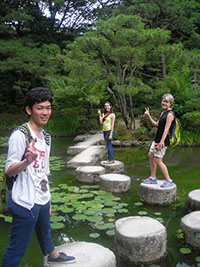
The Steps Ahead: Another photo of our trip to Kyoto, only this time at Heinan Shrine’s garden. It was so beautiful and peaceful, with a lovely and bright path ahead.
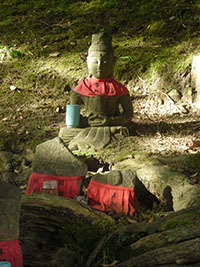
Reaching Enlightenment: This statue was one of many at a small shrine in Nara. The sunlight in this photo is perfect and captures the essence of true enlightenment and peace for me.
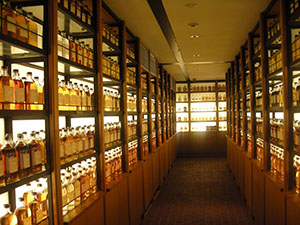
A Wall of Whiskey: One of the best decisions I made was spontaneously booking a tour at the Suntory Yamazaki Distillery (in Japanese!). This photo is of their whiskey library, a collection of all of the different types of whiskeys they have ever created.
Research Update
Last Friday, we tested indium arsenide (InAs) to determine whether we could detect the terahertz emission from this sample. InAs is an important second step since it is harder to detect terahertz emission from it compared to a photoconductive antenna (from which we were able to detect a signal), but it is easier than for the MoS2-Si sample. Additionally, InAs mainly emits terahertz waves laterally, which is similar to the MoS2-Si sample, which may prove to be a problem since our system detects emissions vertically. When we tested InAs, we detected a slight signal (though this was likely only noise). Perhaps with more precise fine-tuning of the system, we will be able to achieve a slightly larger signal, but it seems unlikely that this system will be able to detect terahertz radiation from InAs, let alone MoS2-Si. The next step will likely involve using another system that can detect terahertz emission laterally (but which has poorer resolution). It therefore seems very unlikely that I will be able to see the final results of this project by the time I finish this program, which is very unfortunate.
I was also able to try my hand at aligning for the first time, and though I am currently terrible at it, with more practice on a less sensitive and valuable system, I am sure I can improve in my abilities. TJ will soon be finishing measurements on another system and will need to entirely disassemble it. I am really looking forward to helping to then align a new system and to do more hands-on work. However, I will not be able to start this work until the last measurements are made by TJ. What kinds of things can I do in preparation for learning to align a system without being able to practice on a system itself?
Part of my reason for wanting to stay on Honshu was to experience more Japanese religion and culture and fully utilize my language skills. Though I have been able to experience a great deal of the culture through different landscapes, food, religion, and festivals in Osaka and other nearby regions, I have not been able to practice my Japanese as extensively as I thought I would. My research laboratory is international, meaning that English is the primary language of the laboratory. As I often do not see the Japanese undergraduates in the laboratory whom I could speak Japanese with, and the Japanese post-docs and master students are too busy to practice Japanese with me, I have spoken almost no Japanese in laboratory. TJ is from the Philippines and does not speak much Japanese, which has helped with research explanations but also gives me little chance to speak Japanese in lab. So far, I have spent the majority of my free-time reading articles about terahertz emission and systems and have thus not reviewed much Japanese on my own, though I hope to do so more in these coming weeks as I become more familiar with my project. The few instances in which I am given the chance to speak Japanese have shown me that I still have quite a ways to go. I recently got a haircut and used some basic phrases that the barber probably could have understood in English such as “前髪がほしいです” (“I want bangs”). Still, it was good to try. I also attempted to indicate where I wanted certain sections longer and shorter by pointing at sections of my hair and saying either “長い” or “短い” respectively. That method only somewhat worked. Probably the most effective thing I did was simply to take a picture of a style I liked and say, “写真のようにしたいです” or basically, “I want to look like the picture.” Nonetheless, despite my difficulties, these kinds of experiences have been the most beneficial in making me use Japanese phrases and grammar structures that I am less comfortable with, and I will continue to study and attempt to improve my abilities to shop, dine, and do basic daily life activities in Japanese. The other main way I have been learning Japanese so far has been picking up random words here and there. For example, when I went to the Osaka Wholesale Market, I learned the word for auction (せり), tuna (まぐろ), bonito (かつお), squid (いか), and octopus (たこ). At Tennoji zoo and Osaka Kaiyukan Aquarium, I learned a variety of animal names, which I can proudly recite entirely from memory (though how often I will need to know sardine (まいわし), I am not sure). I have found that the zoo and aquarium are great places to learn more words as they are often geared towards kids and have many of the animal names in either hiragana or katakana. When given the opportunity, such as on daytrips with lab members or other Japanese people, I attempt to speak as much Japanese as possible, but I also notice that I say many of the same things and feel safe with my over-used phrases. Therefore, I think the best way that I can continue learning will be to review the grammar patterns I learned this past year and try to incorporate them into daily conversation. I will of course continue my study of Japanese back at my college, and though I will be taking Advanced Japanese, I realize how far I truly am from advanced. Nonetheless, I am really excited to improve and study even harder before I return back to Japan next spring (hopefully) and see how far I have come.
The Okinawa Institute of Science and Technology (OIST) was unbelievable. The state-of-the-art facilities and wide variety of projects available were astonishing for such a young university. I love that OIST gives its students so much independence in designing their projects and really encourages the student to take charge of his or her own project. This organizational structure is entirely different from that of a traditional Japanese university where hierarchy is strictly followed, and projects are often dictated by the sensei. Along with the generous stipend and the liberal arts emphasis on learning a broad variety of subjects, I am very much drawn to OIST for graduate studies and will definitely consider it when the time comes. However, I do worry a bit about the isolation, and, after being spoiled by the wonderful public transportation on the mainland, it would be difficult to be stuck on a beach for five years, even if it is one of the most beautiful places I have ever seen. Nonetheless, with the close support of an advisor and strong friendships with the other researchers, perhaps I will become so immersed in my research and education that I will not notice the isolation much (after all, I do go to school in Grinnell, Iowa…). The MTSA conference was very nicely organized, and I enjoyed all of the presentations and posters; I just wish I was better able to understand them. The student research presentations were the most beneficial as many of the students were other NanoJapan students who thoroughly explained each aspect of his or her project, making it much easier to understand since no base knowledge was assumed. I would definitely like to continue to attend conferences like these, and I am excited for the day when I become an expert in my field and can fully appreciate the work of so many brilliant researchers from around the world.
It was extremely comforting to have the group discussion about research thus far and to see that many others were in the same boat as I. Though results would be an extra bonus, my main hope for my time here is to learn something that I could not have learned without a mentor or on a computer. Thus, I am very excited to learn how to align my own system where I will be able to make my own mistakes and thoroughly grasp what is happening in the system as it will be my own (and much simpler than the one I am currently working on). Nonetheless, I am very excited for what is ahead as TJ and I (if we receive approval) will be rearranging our current system, which will involve using parabolic mirrors to collect and direct the terahertz signal to the detector as well as a rotating stage to determine where the strongest terahertz emission is coming from.
Question of the Week: Are Okinawans considered ethnically different from other Japanese people? Is there a reason why Okinawa tends to attract more foreigners and is more racially diverse than much of the rest of Japan?
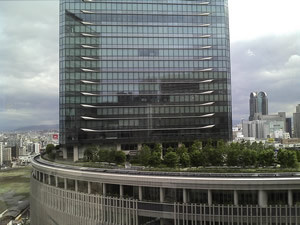
Green Architecture: This picture was taken on the top floor (11th) of Osaka Station, which overlooks the entire city. I found this building particularly interesting as it has plants and trees all along its rooftop, which seems quite uncommon.
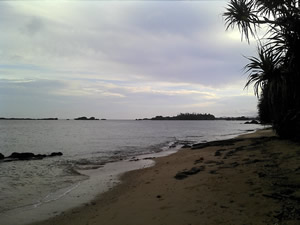
A Day at the Beach: This is a view of the OIST Seaside House beach. Though storm clouds loom, it barely rained in Okinawa, and the beach always had wonderful weather. Unfortunately, this photo does not capture the many shades of blue of the ocean, which was the best part of the beach.
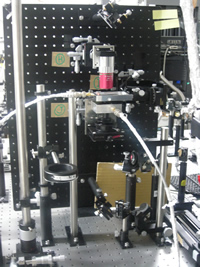
Adjusting the System: This is the current set-up of the terahertz system I am working with. In the coming weeks, TJ and I will be adjusting it in order to detect lateral terahertz emissions from the MoS2-Si heterojunction.
My lab is very laid-back and has few rules. Most of the rules are considered common sense and are tacitly expected, such as treating each other with deference, listening to one’s superiors and following their orders, cooperating with one another, maintaining a strong work ethic, and being prepared for presentations. From my experience thus far, there are few rules emplaced but rather high expectations. Lab members are obliged to work long hours and contribute significantly to the group as a whole. To work significantly less than other members or to not be prepared for a presentation reflects very poorly upon the person, and the senseis definitely do express their dissatisfaction, though I have found they are more direct about it than what we were told during our pre-orientation program. Everyone uses the deferential titles, such as san and sensei, but almost no one uses kun or chan. I have not been referred to as “Rebecca-chan” yet, though this also may be because the lab uses mostly English when speaking with international students, which would make using titles other than deferential titles slightly awkward. Additionally, almost no one argues in the lab, and disagreements are few and far between. Usually, people just gently correct each other or make a suggestion. However, if the advice comes directly from the senseis, no one argues back. The lab member’s duty is to listen, learn, and then execute, not fight back.
Though I have not yet asked to stay in Okinawa for an additional two days to snorkel (I cannot believe I missed that chance!), I have found that my lab is very laid-back, and most requests are granted. That being said, taking two days to snorkel in Okinawa probably would not float with my lab either. However, in terms of working schedule, everyone is given flexibility in when they come and go, which I appreciate a lot. Those that come earlier often leave earlier while those who come later stay late into the night working. Some even come in on weekends to finish up projects, which I think is great since it shows dedication and love of one’s project. On this note, working these long hours in lab is valued in Japan. Whereas in the United States simply getting the job done would be enough, it would appear lazy in Japan not to also show up for an extended period of time, even if it means that not all the time is used most efficiently. There is also more emphasis placed on listening to one’s superiors and working in teams. The United States fosters lots of collaboration, but ability to work independently is more greatly valued there than in Japan. Perhaps it is because Tonouchi Laboratory has so many international collaborations that there is such emphasis placed on working not only with other students but also with many other labs both within the country and around the globe.
I do not do research at Grinnell College, but from my previous research experience at Iowa State University (ISU), I would say the lab experience is very similar. For both of my research experiences, there have been regular mandatory research presentations and updates, followed by extensive questioning from other members and the professors. Another similarity has been spending most of the time with my mentor with only occasional talks with the senseis (usually a quick update on how things are going). However, since Tonouchi’s lab has three senseis, I do stay in somewhat more regular contact with the senseis, which is slightly different from ISU where the professor managed over thirty students alone and had little time to talk to undergraduates. Of the few differences I do see, I believe they mainly stem from the type of research itself. At ISU, I performed computational analysis of organic photovoltaics using BASH code written by my mentor, who worked very independently and consulted only with the professor when he needed help. In a research setting dedicated to experiments rather than simulations like Tonouchi’s lab, students are constantly working with one another not only to discuss projects and compare results but also to arrange who can work with what when, getting samples created by other members of the lab, and even using their systems to test and validate their results. There is a lot more collaboration between different students for these reasons. On another note, it has personally been a bit more difficult for me in Tonouchi’s lab than my former lab because I cannot be as independent as I used to be. In my prior research, I learned many terminal commands that could easily be used in a variety of settings. If I did not know the command I needed to use, I could look it up on different forums or other internet sites until I figured out what to do. Once I was shown how to use the code, I could run it many times for a variety of different Biot numbers, blend ratios, and other elements that altered the microstructure of the polymer-fullerene system. Additionally, learning how to run one type of code helped me to quickly understand how to run the others. Here, on the other hand, I find I cannot really help TJ with aligning the system unless he sets up everything in advance for me and tells me exactly what to do. Even showing me how to align a certain object does not really give me independence since each part must be aligned slightly differently, so it will not be until I learn how to design and align a whole system that I may even attempt to align another on my own. Usually, I am most helpful in simple tasks such as turning on and warming up the laser, finding different components needed for the system, and taking notes/making diagrams. It has still been a magnificent learning experience for me, but I wish I could feel less like a hindrance and be more helpful on my own. I do not believe this feeling has anything to do with me being in a Japanese lab compared to an American lab but rather, again, just the differences in the kinds of research. Experimental research requires a good mentor to learn effectively, and that is just how it is.
Since formal rules have not been much of a problem for me, I will elucidate some of the less well-known rules I accidentally discovered. One such rule: Don’t be an American cook in a Japanese kitchen. Or, more importantly, do not trouble others with your problems. Let me explain. I was talking about my cooking in the dormitory with TJ one day when he jokingly (or maybe not so jokingly; it is difficult for me to tell) told me that I should bring lunch sometime. I took him very seriously and decided that, as an American, I should cook something uniquely American. Over the past couple days, I sampled several different kinds of burgers at multiple fast food chains. Though they are better than their American counterparts in quality, they are not as good as a traditional grilled burger. So of course, I decided to make burgers. Furthermore, I resolved that they had to be fresh, and so instead of cooking them at the dormitory and bringing them to the lab, I would cook them in the kitchen next to the lab. So on Friday, I carted all the ingredients as well as my pan to the lab’s kitchen. For anyone who has ever cooked a stovetop burger, one knows that in order to keep the juices and flavors inside the burger, one must not open the lid more than two times: once to flip the burger and once to remove it. Of course, this proper method leads to a problem: lots of smoke. I think it is pretty obvious what happened after that. The smoke alarm went off, and an angry secretary came in, demanding to know which lab I belonged to. After fetching Kawayama-sensei and an employee at Osaka Gas, everything was determined to be fine, and everyone left except for the secretary. She then told me that the kitchen was not to be used for cooking unless it was for a party. However, I am almost certain that this rule is false (after all, I have seen several people cooking their lunch on the stove); what she really was trying to tell me was that I could not use the kitchen because I inconvenienced several people. Though I do feel bad for my actions (and have thus resolved never to set the kitchen on fire again), it did seem a bit over-exaggerated in severity, especially since in America, I would simply have been told to stop and not do it again.
Question of the Week: We were told that Japanese people are not very confrontational. Is this the reason why I was given what I consider a false reason for why I could not use the kitchen instead of being told directly that it was because of my mistake?
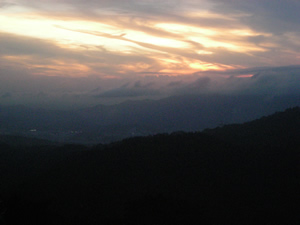
Working for the Sunset: I definitely underestimated how far the bottom station of Nunobiki Gardens was from the summit of Mt. Maya (just over 10 km I think?)… In fact, I just assumed I could do it. Though I was extremely tired when I summited, I was lucky enough to catch the glorious sunset. I also made it for the famous night view of the surrounding city alight, made all the better since I climbed all the way to get there.
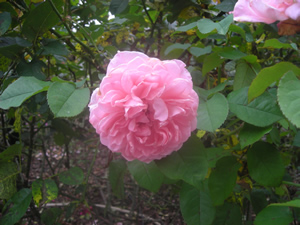
Stop to Smell the Roses: I never really understood this phrase until I smelt the roses at Nunobiki’s fragrance garden. They are definitely the most fragrant flowers I have ever smelt, and they smelled of sweet lychee!

I Swear, I Don’t Always Set Things on Fire: I promise I’m not that bad of a cook. The burger still looks edible, and my lab mates seemed to enjoy the teriyaki chicken I made for a picnic at Expo '70 Commemorative Park (I learned my lesson the first time and did not use the kitchen in the lab to make this dish).
Research Project Update
TJ and I are setting up a new system equipped with a rotating stage in order to find the direction in which the sample emits the most terahertz waves and are adding parabolic mirrors in order to capture and direct as much of this radiation towards the detector as possible. Unfortunately, we were told after we disassembled the previous system that our assumption that we could not detect terahertz emission from laterally emitting MoS2-Si heterojunction was not necessarily true and that InAs was not an accurate predictor for whether we would be able to detect terahertz emission from MoS2-Si. Even still, creating a new system has been a valuable learning experience for me, not only in learning to align a system but also in preparing the parts, measuring the distances of the trigger and probe beam paths, and constructing a diagram to ensure that all parts were accounted for and that the distances of the two paths are equal. Additionally, I hope this new set-up will be useful in analyzing other materials and give the system more flexibility in its usage. We are now also simultaneously using Sakai-san’s system with a teraspike detector. So far, we are getting readings for InAs, which is promising, and will be testing Salek-san’s solar cells for a more accurate idea of whether we will be able to detect terahertz emission from the MoS2-Si heterojunction.
To understand and learn more about the differences between American and Japanese labs, I recently interviewed Serita-san, a post-doc at Tonouchi laboratory. Serita-san has a Ph.D. in Electrical and Information Technology Engineering. Unlike many of the researchers who happened to stumble upon the terahertz field, he chose to study terahertz because it is a very unique field with many promising applications for electronics. Since the terahertz region represents a gap between electronic and optical applications, it presented a challenge for Serita-san and excited him to understand more about terahertz and the potential applications for this field.
He really enjoys working in Tonouchi laboratory for several reasons. For one, Serita-san feels lucky since this lab has the funding necessary to acquire expensive equipment, which has allowed him to pursue research that genuinely interests him. When he comes up with a new idea, he only needs to ask sensei’s approval in order to be able to pursue it. There are also many international students, which allows him to improve his English and learn more about other cultures. Due to Tonouchi lab having so many strong international connections (in the lab alone, there are ten or so international researchers representing a variety of countries, including South Korea, China, the U.S., Philippines, Bangladesh, and Madagascar), there are many international collaborations. These connections have allowed Serita-san to work in several different labs abroad, including Vienna University of Technology, where he spent two months as a first year Ph.D. student as well as Kono-sensei’s lab at Rice University this past year. In Austria, he immediately noticed the difference in the amount of individual attention he was given. Unlike in Japan where the senseis barely have time to talk to students, the associate professor at Vienna University of Technology served as his mentor and was able to guide him in his experiments and advise him on how to develop his system. In Japan, the senseis are far too busy to focus all of their attention on one student, let alone experiment with them. He also noticed that the labs there were much more spacious. Everyone had their own personal office space (or only shared the space with one or two other people), which made it easier to concentrate. It was similar in Kono-sensei’s lab. Even still, Serita-san appreciates the atmosphere of Tonouchi lab. Despite the office being cramped, it helps foster stronger communication between other lab mates. Additionally, in Kono-sensei’s lab, he noticed that instead of sharing lasers (as is common at Tonouchi Lab), each table had one system and one laser. Labs were also cleaner and newer. He was surprised that Japanese researchers worked much longer, often late into the night, while most researchers in the U.S. tended to leave around 6 pm. For Serita-san, that time schedule would be more ideal since there is not always enough time to see his wife and daughter when he is so busy with research.
He was thoroughly impressed by the efficiency of his international collaborators. In one case, an exchange student from Australia was paired with Serita-san at Tonouchi Lab. The Australian student worked closely with Serita-san, and eventually told a colleague back home about his work in Japan. The colleague then suggested several simple experiments for Serita-san to run for his research. It took a few weeks, and then Serita-san sent the results back. The colleague quickly wrote the paper in another two weeks and submitted it, where it was swiftly approved and published. Their efficiency due to timely scheduling was a valuable lesson to Serita-san, who has since cherished organization and creating a timeline for research.
As he has already completed a Ph.D., it would be difficult for him to get a company job, where only one or two students are hired (often doing further research in the same field) since companies often want younger students. As in America, it is often after obtaining a master’s degree that students then enter a company position; otherwise, those with higher degrees often pursue jobs in academia. However, Serita-san would like to continue research, specifically the research he chooses. Though the salary of post-docs is not very high, they are allowed to follow their ideas and dreams in research. They get to develop their own systems, find unique phenomenon never seen before, and seek their own path; this pursuit of one’s dream is the most important thing to him. At a research position with a company, one is paid a higher salary but must follow the orders of the company, which often means not conducting the research one would like. It is a constant struggle between higher salary and following one’s true passion.
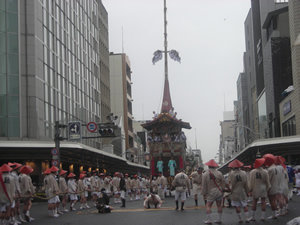
Pulling Your Weight: These traditional floats for Gion Matsuri are not light at all. Weighing around 12,000 kg, they require 30 or more men to pull them. Even more impressive is that they are pulling them through a torrential storm courtesy of the passing tsunami. 頑張りましたから、ありがとうございました!
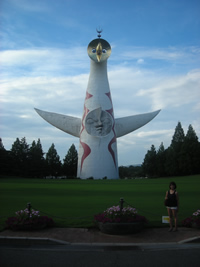
The Symbol of Suita: I am standing in front of the symbol for Suita Campus, which is in the middle of Expo ’70 Commemorative Park. I had a lovely picnic with my lab mates, and I am honored to have such a wonderful lab.
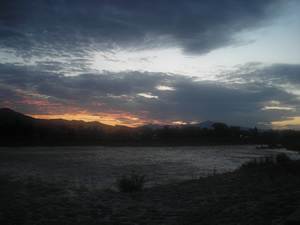
Sunrise over Arashiyama: With all these pictures of sunrises, I figure my sleeping schedule must be pretty horrible by now. Nonetheless, the sunrise was glorious, and it makes me miss sweet and beautiful Colorado just a little bit more.
Research Project Update
This past week, we have done much but unfortunately without much result. We tested a solar cell sample using Sakai-san’s TeraSpike system. The solar cell is supposed to more accurately model whether or not we will be able to detect terahertz emission from the MoS2-Si heterojunction compared to InAs. However, the results are inconclusive due to the photocarriers of the solar cell having longer carrier lifetimes than the amount of time between each laser pulse. Therefore, the signal is distorted by the laser itself, and the intensity of the laser would need to be adjusted to get accurate readings for the solar cell. Nonetheless, we then tested the MoS2-Si heterojunction. We again got distorted data due to laser interference (the laser and the terahertz emission both reached the detector). Currently, alterations on the vertical lens system (TJ’s system) are being completed. Previous tests on the flat stage failed to detect terahertz emission from InAs, so a new stage rotated 45° has been substituted. However, aligning this system is proving difficult since it is challenging aligning parabolic mirrors with such limited space. For this reason, no emission was seen for InAs. Therefore, we tested the solar cell in another system, the gas chamber-vacuum system (TJ’s other system) to see if we could detect terahertz emission. It appears that the signal to noise ratio is too low, even for high powers of 50 mW and 70 mW (beam spot of approximately 800µm). Previous tests conducted by Salek-san on the solar cells yielded results when the parameters were set at a power of 3 mW with a 50µm beam spot. Therefore, we ran similar tests using lower powers of 5 mW, 10 mW, and 15 mW to avoid saturation effects, but we still saw no emission from the solar cell. Still, we tried the MoS2-Si sample, but achieved similar results as the solar cell.
We are now going to reassemble the old system with the detector back on the vertical board (and without parabolic mirrors), and I will image the MoS2-Si samples (both with and without PMMA protective coating) and take Raman spectroscopy data of the samples to see how the samples have aged and changed with time (specifically looking at the deterioration of the MoS2 monolayer flakes).
I was stunned when I read that the manager of the Prada division of Japan told Hiroyuki Takahashi, the senior human resources manager, that she would need to lose weight in order to continue representing the fashion company. Already, several employees had been transferred for not upholding the Prada look. When Takahashi filed a lawsuit, the judge ruled that her employer had every right to tell her to improve her physical appearance. Such stories are not uncommon, even in America. Abercrombie & Fitch, for example, has been under similar scrutiny. Still, the Japanese workplace remains an especially tough place for women, especially women who hope to rise to high managerial positions. Besides hiring discrimination, there are a variety of other barriers, the greatest being social considerations and family. Even if a woman should rise to the top of the workplace hierarchy, it is almost impossible to keep that job if she wants to start a family. Employers often force women to choose between corporate success and family; almost no one can have both. Therefore, it comes as no surprise that when women have their first child, 70% stop working for a decade or more, which is more than double the percentage of American women. The labor force participation rate of Japan, 63%, is predictably far lower than most other developed nations. Of the women that do return to the workforce, many end up only being able to secure positions as part-time and temporary workers. Additionally, many of these women are not content with their jobs. The main reason cited for leaving jobs was dissatisfaction and a feeling of being put in dead-end roles (compare this to America where child and elderly care are the main factors). Because Japanese women are some of the most well-educated and their potential is being under-utilized, Japan’s economy has suffered, particularly since declining birthrates have resulted in a lack of laborers.
Workplace difficulties continue within scientific research fields as well. The disparity between the number of female scientists compared to male scientists is alarming around the world, but none more so than Japan, where the gender gap is even greater. In Japan, only ten percent of the researchers are female. Already, the number of female scientific scholars is low at only thirteen percent compared to 66 percent in the humanities. In engineering, that percentage drops to just two, which explains why there are no female researchers in my laboratory and very few in the other NanoJapan students’ laboratories as well. Female researchers feel compelled to leave as their opportunities in Japan as women are sometimes discouraging and limited (60 percent of Japanese female researchers work abroad). They are also seen as not desirable marriage partners. They are “too manly,” and they lack the soft character and agreeability desired by Japanese men. Female scientists want to determine their own lives and not be led around, and their ability to argue logically and find truths apparently intimidate many men. There is also a stigma against a woman having a higher degree than the man she marries, especially if the man is also of lower social status. Surprisingly, the stigma is also perpetuated in part by Japanese women themselves. A recent survey showed that a third of young women want to become full-time housewives, and a similar percentage also agreed with the statement that women should stay at home and take care of the family rather than be part of the workforce.
Despite the difficulties for women in Japan, being a foreigner on a short visit, I have felt little discrimination for being female, both in general and in the laboratory. However, in the long term, I would be upset if I had to choose between career and family as I very much want to have both. The difficulty in balancing the two would definitely prove problematic if I decide to live in Japan unless Prime Minister Shinzo Abe succeeds in creating daycares and other support systems for working women and families. Without them, I am not sure I would want to live in Japan, as lovely as it is.
Haruko Obokata was meant to be a role model for all female Japanese scientists. She had found a way not only to be a talented and successful researcher but also to stay beautiful and feminine. As a non-traditional scientist, she often wore makeup and dressed up, and, rather than donning a lab coat, she would wear a traditional apron. Obokata represented the perfect balance between being intelligent and glamorous. Obokata reached prominence when she discovered the phenomenon she named stimulus-triggered acquisition of pluripotency (STAP). In a too-good-to-be-true experiment, she tested a variety of environmental stresses to induce cells to become pluripotent. She determined that using acid (or substances with low pHs), bacteria toxins that perforate the cell membrane, and/or physically squeezing blood cells allowed them to be persuaded to become any kind of cell, including placental ones, something that neither iPS cells nor embryonic stem cells can do. She then was able to create dozens of cell types, including brain, skin, lung, and liver, opening up endless possibilities to cure a vast array of illnesses and make cloning easier. However, the experiment proved to be faulty. Concerns began to surface about her research when several groups attempted to replicate her results without success. With further investigations, it was discovered that there were glaring errors in her publication, including diagrams where the lanes of electrophoresis gels had been switched as well as the use of one image taken from her doctoral thesis to describe two different stressors.
Her paper, in which she was the lead author, was then retracted from Nature. After such overbearing shame, her supervisor hung himself, and Obokata became mentally unstable. The fairy tale had turned into a complete and utter nightmare. Despite her academic dishonesty, I hope that she still serves as a positive role model for Japanese women to continue to enter the research fields (of course, though, conducting honest research). My main fear is that after this controversy, there will again be no recent Japanese women role models in the sciences, and women will again be afraid to enter these kinds of fields.
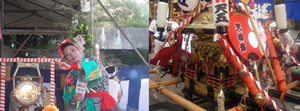
Celebrating Tenjin Matsuri: Tenjin Matsuri had the festival atmosphere that Gion Matsuri lacked. Filled with food stalls, children’s games, parades, dancers, river boats, and fireworks, it was absolutely spectacular.
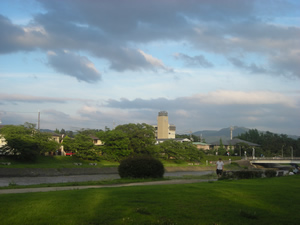
Calm by the River: A day out with Manja, TJ, Haja, and Alena by the Kamogawa River in Kyoto. It was a wonderful and relaxing way to spend the evening after an eventful rest of the weekend.
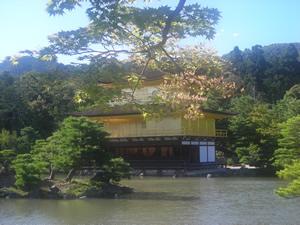
Golden Paradise: Kinkakuji Temple is always splendid, but it is made even better by the leaves that are beginning to change color, signaling the start of a lovely autumn.
Research Project Update
As the MoS2-Si sample is over a month old, we wanted to view the effects of age on the deterioration of the MoS2 monolayer flake and determine whether this deterioration may have had a detrimental effect on the detection of terahertz emission. Therefore, Raman spectroscopy tests were performed on both MoS2-Si with PMMA removed and with PMMA intact. Though the MoS2 monolayer flakes were rapidly deteriorating, there were still several sections that were fairly intact with many triangles of MoS2 left. However, other areas show much greater depletion. Note that in the Raman spectroscopy image, the warm colors (red, orange, and yellow) signify Raman peaks characteristic of MoS2 whereas cool colors (blue, green, and purple) signify peaks characteristic of silicon. Based on these early preliminary results, there is reason to suspect that the green blobs surrounding flakes of monolayer MoS2 are coalesced versions of MoS2 (bulk). Further studies into the distances between peaks will be required in order to determine the thickness of these bulk MoS2 accumulations.
The vertical lens system (Tanaka’s system) has been rebuilt, and the terahertz imaging feature is working. Nonetheless, detecting terahertz will prove challenging.
I went to Japan with few presumptions and was not sure what to expect. Though I went in confident that I would like Japan, I have found it different from what I expected. For example, Japanese people in general are quite different from what I imagined. At Grinnell, the study abroad students from Japan are incredibly outgoing and talkative as are my Japanese senseis. After visiting Japan, I would say that the study abroad students and even the senseis at my school are quite different from the normally reserved and quiet Japanese people. However, everyone I have met, from the KIP students to my lab mates and senseis, have been extraordinarily welcoming and helpful, so it was an easy transition even if people did not act quite as I expected. In honesty, I imagine that this difference in personality stems more from a lack of confidence in English speaking abilities than anything else. Ironically, I naively assumed most Japanese people would speak English very well and feared I would have little chance to practice Japanese in an out-of-class setting. That assumption, of course, would prove to be false. I have reaffirmed that taking the time to try to learn and speak Japanese can really build a relationship with those who are not so confident in their English speaking abilities and that Japanese people become less reserved when spoken to in a language they are more comfortable with. There is definitely much value in learning the language of the country, whether to make friends or to better understand the culture, and I will take this lesson with me wherever I go.
The United States is a country full of very friendly and outgoing people. Unfortunately, this group does not include the airport security personnel at George Bush Intercontinental Airport, where I felt unwelcomed to say the least. Coming back to the U.S. to be herded like sheep and treated like an object was eye-opening, especially after the courteous service I received in Japan. It was not the warm welcome I had hoped for or expected, which in many ways caused an influx of homesickness for Japan. However, coming back to the U.S. has reminded me of all the ethnic diversity that exists, and I never realized how much I appreciated that Americans speak their minds and confront differences and problems head-on rather than avoiding them like the Japanese. For example, one of the NanoJapan students recently got in a heated debate on abortion and presidential candidates with an elderly couple. Even though their viewpoints differed and there was a bit too much tension, I appreciate that Americans are willing to confront their different viewpoints and really talk them through. A discussion such as I saw would never have occurred in Japan.
I feel very much changed for the better in many ways. Japan has allowed me to spread my wings in being completely independent for once. Though I experienced this somewhat in college before as well, I was much more alone this time, which allowed me to better connect with myself. There were nights where I could just sit on my sixth floor balcony and stare out at Toyonaka Campus, thinking of how much my perspective on life has shifted. Japan has been filled with its fair share of ups and downs, but I have come to appreciate it all. I once held the belief that sadness and pain were important only in the context of fully appreciating happiness and pleasure. Being in Japan has taught me that all of my experiences, whether good or bad, are valuable in and of themselves and not merely in the context of other experiences. More difficult situations were valuable lessons learned, and, more importantly, just another unique and powerful experience in this crazy adventure called life. Having all these experiences has made me a more aware and fuller person, and I love my life for all the memories it is filled with.
There were few frustrations living in Japan, though perhaps that stems simply from the fact that I was there for such a short period of time. The only one might be that public transportation does not operate at late night and early morning hours, so staying at lab late and/or having a night life can get quite pricey. The last bus that left from my lab was at 7:10 pm, which was quite early and sometimes did not allow enough time for research. Taking the Osaka Monorail to work every day, however, would be about ¥3,700 a week. Luckily, sleeping at the lab was possible, so there was little worry of being stranded. Additionally, as an eight week stay, I decided I wanted to cook my own meals. However, the nearest grocery store was just over two km away each way, and, when loaded with groceries, the distance did add up. Still, it was nice to be able to get around without a car and to be fully independent, even if it was a bit of a struggle at times.
The final week of lab was absolute chaos. The optical and terahertz imaging systems were finally working, so the objective was to first image the photoconductive antenna and then the MoS2-Si sample itself. It was somewhat difficult to find areas that were recognizable on the sample compared to finding the center of the PCA, and even then, the resolution and alignment were not good enough to resolve the MoS2 monolayer flakes. Still, it was really cool seeing the system finally work, and I wished I had had the chance to work with it more and more fully explore its capabilities. It was also busy because I made many of the goodbye presents (for better or worse… I’m not exactly the most crafty person unfortunately), which took much time and effort. There was also a going away party where we ate okonomiyaki, an Osaka specialty, paired with beer, a truly winning combination. It was a really wonderful party, and it actually fills me with a great sadness leaving it all behind. Still, I hope to go back, and I am really excited to visit again and see the progress that Cody and TJ have made on the project. I am sure they will accomplish a great many things. I would love to stay in touch, and I especially hope that I will be able to go back in March and see all the amazing work being done. MoS2 has interesting applications for solar cells, but most likely, terahertz research will not be something I continue. It was great being able to explore a completely different area than the field I am used to, however, and I really am quite glad that I got to try optics research rather than stay in my comfort zone, where I do not think I would learn as much.
Despite not always accomplishing all that I would like to accomplish, I realize how much I love research. It can be slow, it can go wrong, it can result in no results after weeks of work… but even still, each day is always something new and exciting. I already like it so much, and I know that when I get to create my own projects and am competent enough to do work alone or actually assist others more effectively, I know I will be even happier. Both my research experiences thus far have been incredible, and I really look forward to continuing on in this amazing journey as an aspiring renewable energy engineer.
Of all the wonders of Japan, for sure I will miss the people the most. I did not expect to become as close to the KIP students, my lab mates, senseis, and even random welcoming strangers as I did. Truly, it was the people and being with them that has made this experience so fantastic. Of course, a close second was the beauty of all the places I was able to experience and the remarkable cultural and religious influences that have shaped this land.
We climbed Mt. Fuji during the final weekend, a NanoJapan tradition. We were incredibly lucky because the weather was absolutely lovely, a luxury that was not to be had last year. Mt. Fuji was a somewhat arduous climb with many steps and many areas where there were just random rock scrambles, and these proved to be challenging but very fun. I hiked mainly with Jacquie, and since we were not with the rest of the group, we had a very interesting experience hiking with another group climbing Mt. Fuji. Ironically, one of the people in the group was from Castle Rock, Colorado, just twenty minutes from where I live. It was a crazy scramble trying to make it to the summit on time simply because the line to get on the summit was so long. However, I’m glad to say I made it, and the view was incredible. We were high over the clouds with the sun just peaking up past the clouds, which eventually exploded in pink, orange, and red bursts. I had never before seen such a vividly red and perfectly round sun. Indeed, Japan has earned its nickname of “The Land of the Rising Sun.” I never cease to be amazed by the incredible beauty all around us. Jacquie was incredibly sweet and even followed me on my crazy plans to go to Fuji-Q Highland Amusement Park right after, where we rode Dodonpa, the world’s fastest accelerating roller coaster, and went to Japan’s best Haunted Hospital, which I found hilarious rather than scary. It was a great time, and though sleep was lacking (as per norm), I thought it all to be very worthwhile.
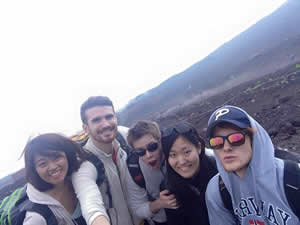
Descending Mt. Fuji: Mt. Fuji was a stellar climb, and I thoroughly enjoyed the hike up and the incredible sunrise. From left to right: Myself, Nate, Brady, Natsumi, and Phil.
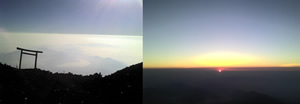
On Top of the World: A beautiful sunrise, and the last sunrise I would see in Japan. So thankful to have seen it all. There was also a really cool Torii gate overlooking the edge.
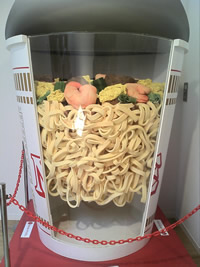
A World Full of Noodles: Right before going back to Tokyo, I visited the Momofuku Ando Instant Ramen Museum and learned all about the history of Cup Noodles. People dream up some pretty fantastic things.
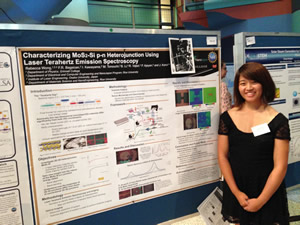
Title: Characterizing MoS2-Si p-n Heterojunction Using Laser Terahertz Emission Spectroscopy ![]()
Host Lab: Tonouchi Laboratory at Osaka University
Mentor: TJ Bagsican
Introduction: Atomically thin two-dimensional (2D) materials demonstrate markedly different properties from their bulk (3D) counterparts, which could lead to interesting applications for optoelectronic and electronic devices. Advancements in the creation of these 2D semiconductor materials have expedited the fabrication of a variety of 2D-2D and 2D-3D van der Waals heterojunctions with novel properties compared to those of typical covalently bonded semiconductor junctions. However, the characteristics of 2D-3D semiconductor junctions have not yet been extensively studied and are therefore not well understood. The results of this study will provide new insight into the nature of the MoS2-Si p-n junction energy states (e.g., band alignment and bending) as well as allow us to better understand how the properties of 2D-3D junctions differ from those of conventional 3D-3D junctions.
Approach: In this study, we examined the emission of terahertz radiation from a heterojunction created with n-type monolayer MoS2 and p-type bulk Si using laser terahertz emission spectroscopy. Using a unique vertical lenses system with optical and terahertz imaging capabilities up to 1 µm, we performed optical and terahertz imaging first of the PCA for alignment purposes and then of the MoS2-Si heterojunction.
Results: Though the shape of the photoconductive antenna was able to be resolved as well as the outlines of the numbers and trenches on the MoS2-Si heterojunction, finer tuning will be required to achieve higher quality optical images and eventually terahertz images. The current resolution is approximately 5 µm, though resolutions up to 1 µm should be achievable. Additionally, the rapid deterioration of the p-n junction due to oxidation of the silicon makes this process a challenge. Using Raman spectroscopy, we also analyzed the various materials in the sample and determined that some of the monolayer MoS2 had become bulk, though further research will be required to determine if this result is actually the case.
Future Research: An interesting topic of further study would be delaying the deterioration of p-n junction, which would allow for more complete study of MoS2-Si. Side projects could include determining the thickness of resultant bulk MoS2 layers and understanding what leads to the apparent conglomeration of MoS2. However, the main objective is to increase the resolution of the system through further alignment of the lenses near the galvanometer in order to perform terahertz imaging of the MoS2-Si sample.
Conclusion: Further alignment will be required in order to get a terahertz image of the MoS2 monolayer triangles. However, the system functions as shown by the terahertz image result of the photoconductive antenna. As expected, there is only terahertz emission where the beam spot hits the center, an important result. The outline of the PCA can also be faintly detected.
NanoJapan taught me first how to be myself, secondly how to be a researcher, and thirdly how to be a global citizen. I learned that I have the strength to accomplish whatever I set my mind to, regardless of whether it is a solo summiting climb of Mt. Maya following signs written only in Kanji or staying at lab for 10+ hours staring at samples and aligning a system. I am proud of my independence but also know that there were many times in which I required help to get to where I am now, including all the support from my parents and family, the knowledge gained from my teachers, and the love from my friends who helped me through every step of this journey. Through NanoJapan, I truly learned how adaptable I am. Coming from a background of only introductory optics and one other research experience that was entirely computational, I adapted quickly to my new environment of terahertz and optical hands-on experiments. Though sometimes I felt helpless and useless, I learned much about patience and determination. I slowly learned the basics of aligning a homemade terahertz system, taking measurements using a Raman microscope, and finally how to take optical and terahertz imaging measurements. Oftentimes, the terahertz system would not function or there would be unexpected problems with the sample. However, to keep moving forward even when things are not going exactly as one hopes is what defines a capable researcher. It is not entirely about the results; rather, it is about the dedication and heart one puts into his/her work. Research is difficult because it is not straightforward and does not always proceed as anticipated, but that is also what makes it so meaningful and exciting when a ground-breaking discovery is found. It is not always easy, but it is a journey I have learned to appreciate more the more I do it, and I feel confident this path is the right one for me.
One of the greatest lessons I have learned from NanoJapan is not to fear failure. Failure will be present at every stage of one’s life. Things break, results fail to emerge, rejections come. Failure is just another part of life, as is sadness and pain. But on that same note, failure is not something that should be associated with purely negative feelings. It is because of failure that I have learned to keep trying even when the going gets tough. It has taught me to endure and always try again, to never give up in the face of adversity. For those students who are afraid to go out of their comfort zones, to visit foreign places, to apply for a competitive program, I encourage them to just go for it. Failure will not break you but giving up will. Be adventurous, try new things. Most importantly, have the confidence in yourself to do what you want and make your dreams yours.
As part of my follow-up NanoJapan program, I think it would be pretty fun to not only educate high-schoolers on the research I conducted this summer but also to be a motivational speaker for the day. I am not sure if I could do it or not, but it would be incredibly meaningful to me to encourage students to pursue careers in science and strive to be their best. I never had that support in high school, and it would be great to give more support and hope to these young, blossoming scientists. I will of course continue my studies of Japanese language and am looking forward to my advanced optics course in the spring. I hope to continue to become a more global citizen and learn more about the many opportunities around me not only to research at home and abroad but to continue my growth as an environmentally-aware and educated citizen.
I want to send one last thank you to the whole NanoJapan team that made this incredible experience possible. Thank you for giving us and so many others this incredible opportunity to explore not only the world of research but also ourselves. I also want to thank the NanoJapan 2015 cohort; you guys truly made this experience one of the best in my life, and I really hope we all meet again and share where life has taken us. Thank you as well to all of Tonouchi lab for welcoming me and introducing me to an entirely new field of research. I have learned so much and am so glad to have spent quality time with many of you. Research would not have been the same at another lab, and I am glad I got to be part of this family. Finally, thank you to all those who have supported me throughout this incredible journey. I cannot imagine having a better team of family, friends, and supporters in my life. Thank you for blessing me with love and support always. See you soon, Japan.
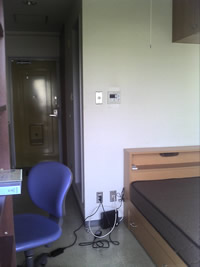
See You Later, Osaka: My empty dorm room. It was a wonderful place, and I am really going to miss waking up to sunlight streaming through the balcony door. Hopefully I will be back soon.

Stages of the System: The evolution of the terahertz system as it was disassembled multiple times, first to include a rotating stage, then a tilted stage, and finally back to the original setup.
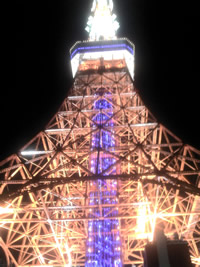
Back to the Beginning: Our final visit back to Tokyo Tower, the very first place we visited when we got to Japan. It was bittersweet to reminisce about the first day but also inspiring to know how far we have all come.
Pre Departure Tips: If you want to visit the Studio Ghibli Museum, you need to reserve the ticket in America. Though you can buy them in Japan, it is so popular among both Japanese people and tourists alike that they are often sold out months in advance. Get them early if you are a big Miyazaki fan! I also recommend packing decently lightly (especially clothes-wise) as you will definitely want to buy a lot of interesting gifts from Japan (but make sure you pack gifts from America for ALL of your Japanese senseis, secretary, and mentor as well as random trinkets to thank people you meet on the way).
Orientation Program Tips: I recommend learning some basic, useful Japanese phrases on your own as many Japanese people do not know much English. Also, being in Tokyo is incredibly exciting, so make sure that you explore all it has to offer (but make sure you also sleep as well!). Try to take naps in-between language classes and the nanoscience lectures if possible.
Mid-Program Meeting Tips: Do a practice run through with your presentation before doing the actual presentation. Even if you think you know exactly what you want to say, there are always small details that you can only nail down when you go through the whole presentation. It is also a good way to verify that all the information you want on the PowerPoint is included and that you are able to explain it all.
Okinawa was incredibly beautiful. Since there is no public transportation, the only way to get around is really by taxi. However, visiting any of the beaches (we went to Moon Beach) is a great way to spend a day well and cheaply.
Working With your Research Lab Tips: Talk to everyone you can! I found that speaking Japanese is a great way to bond with native Japanese speakers. It really shows dedication to trying to understand the culture at the very least and is sometimes the best way to communicate once you reach a conversational level. I wish that I had a chance to work with more of the advanced machines and have some of the other home-made terahertz systems explained to me in the early weeks when there still was not too much to do.
Living in your Research Host City: Osaka is a great location. Though Osaka does not have too much outside of shopping, it is a short distance from many other areas such as Kyoto, Kobe, and Nara. In Osaka, I would definitely recommend going to Osaka Castle if you enjoy learning about historical events as well as Mt. Minoo if you enjoy hiking. For myself, I thought it was worthwhile to invest in cooking supplies and cook Japanese food, especially since such items are incredibly expensive in America. However, the nearest grocery store is a decent walk (about 15 minutes each way) and preparing food is often more expensive than the cafeteria meals at Osaka University. Still, the dorm situation at Toyonaka Campus was very well set up, so cooking is relatively easy to do. I also did not need to buy bedding or anything; everything came provided.
Language Study Tips: Learning Japanese using the Hiragana and Katakana alphabets will serve you better than learning just Romanji if you are serious about becoming fluent in Japanese. If you come with some Japanese background like I did and are taking technical Japanese courses, learn kanji. Preview the textbook provided and learn how to read the kanji and guess their meanings based on their radicals. I personally found that research was a bit too time-consuming for Japanese classes, especially since my classes would have been in the afternoon and require a trip back on bus (about 30 minutes each way). However, beginning classes might be feasible and not inconvenient to take.
Other Tips:
I personally brought chocolates for the group lab gift, but if you do so, only buy dark chocolate. American goods are often too sweet for Japanese taste. To be on the safe side, it might be good to bring something salty. Whatever you choose to bring as a lab gift, make sure that each item is packaged individually and not too messy.
Buy lots of sushi! If you go grocery shopping late at night, there are often really good deals (up to 50% off) on all sorts of food. I recommend being there for the early part of the discounts (around 7:30 pm) since people are pretty quick at snatching up the good deals. I would recommend at least trying Osaka’s specialties, which include okonomiyaki (a salty pancake containing vegetables and meat) paired with beer, kushikatsu (all sorts of food, from meat to cheese, fried on a stick), and takoyaki (baked octopus balls).
I really like yukatas (similar to a kimono but made of cotton), so I bought two. The cheapest (while still nice) ones I found were at Tenjin Matsuri, but Kyoto’s Nishiki Market has a good selection at good prices.
I love hiking, so I recommend hiking as many mountains as you can if you do as well. Though Mt. Fuji is likely the most famous mountain in Japan, Mt. Maya was my personal favorite. You get to see all of the Nunobiki Herb Gardens and a beautiful sunset and night view. However, I do feel like it meant more to me having hiked it rather than taking the cable car. But that’s my personal opinion.
My favorite places in Japan include: Mt. Maya, Mt. Rocco, Mt. Minoo, Mt. Fuji, Fushimi Inari Shrine, Kyoto night scene (they have very interesting clubs), Arashiyama, Shinsaibashi, Suntory Yamazaki Distillery (must be 20 or above to go on tour and sample whiskies), Nara Park, Asakusa, Shinjuku, and Kamakura